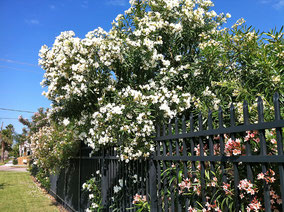- DEUTSCH
- ENGLISH
- SUCHE / SEARCH
Welcome to the wonderful world of Oleanders
“On an island, off the mainland of the state of Texas, is located one of the most delightful cities to be found in America. The city is Galveston, and it contains the most extensive collections of ‘Nerium oleander’ to be found anywhere in the world. Oleanders are planted everywhere – along sidewalks and esplanades, in small gardens and large estates. Truly one would have to visit this city of floral beauty to understand why oleanders and Galveston are synonymous.”
Clarence Pleasants 1966
The Aims of the Society
A scientific or horticultural corporation, for non-profit purposes, to promote, carry on, and aid in every way the development, improvement and preservation of Oleanders (Nerium) of all kinds, including the importation and improvement by cultivation and hybridization of Oleanders : to conduct or cause to be conducted scientific researches for the improvement, development or preservation of Oleanders and for the promotion of a higher degree of efficiency in growing thereof: to collect information relating to the growing and development of Oleanders by such researches and dissemination: to make awards in the form of certificates, medals or otherwise, for excellence in the development or culture of Oleanders, and generally to extend the knowledge, production, use and appreciation of Oleanders of any kind and in any manner.
Oleander Garden Park (Betty Head Oleander Garden, Galveston, Texas)
History of the Oleander in America. By Way of Galveston.
The first Oleanders came to subtropical Galveston in 1841. Joseph Osterman, a prominent merchant, brought them aboard his sailing ship from Jamaica to his wife and to his sister-in-law, Mrs. Isadore Dyer. Mrs. Dyer found them easy to cultivate and gave them to her friends and neighbors. The familiar double pink variety that she grew has been named for her. (Picture on right) Soon these new plants were growing throughout the city.
As early as 1846, note was taken of the yards in Galveston with oleanders and roses in full bloom and the contribution they made to the beauty of the city. Oleanders flourished in these early days of the city and were able to withstand the subtropical weather, the alkaline soil, and the salt spray. Therefore, it was logical for oleanders to be chosen as one of the predominent plants to be used in the replanting of the city following the destruction of the 1900 hurricane and grade raising that covered the existing vegetation with sand.
Concerned ladies of the city soon organized the Women’s Health Protective Association (WHPA) with the mission to beautify the island and improve the health conditions of the city. They planted along Broadway, the entrance to the city, and on 25th Street, the path to the beach front, and in a few years, oleanders made a spectacular display of blooms for citizens and visitors. Although the name of the WHPA was changed to the Women’s Civic League, planting continued for many years up and down city streets, in parks, in yards, around public buildings and schools and soon the whole city became a garden of oleanders. As early as 1908, an editorial in the Galveston Tribune observed that the oleander was emblematic of Galveston and that people came from all over to see them. In 1910, The Galveston Daily News also reported that Galveston was known throughout the world as “The Oleander City” and in 1916, an article named it one of the most beautiful cities in the South.
Through the pollination of the two original Galveston Oleanders, ‘Mrs. Isadore Dyer’ and ‘Ed Barr’, many hybrids have occured throughout the century. Many of these were distributed all over the United States and, today, are growing everywhere the climate is amicable. Today, corals, yellows, reds, pinks and whites in singles and double forms are found in the warmer climates of America.
The International Oleander Society
In May of 1967, through the vision of Maureen Elizabeth ‘Kewpie’ Gaido and Clarence Pleasants, the National Oleander Society (later to be changed to the International Oleander Society) was born.Inspired by Clarence Pleasants (known as ‘Mr. Oleander”) who’s love of this flower he shared with everyone, Kewpie promoted the oleander all over the world. She corresponded with, then Governor of California, Ronald Regan in 1971, after finding out that he had designated many miles of freeway to oleander plantings. She sent him many plants and cuttings in the process. Kewpie also talked with Lady Bird Johnson concerning her own promotion of the oleander around Texas.
Clarence Pleasants saw his first “Oly Andys” in Virginia as a boy and was taken by them and decided to dedicate his life to this beautiful flower. He attended a segregated two room “black only” school until the seventh grade since there were no other grades beyond that point.
He studied under Fredrick Heutte at the Norfolk Botanical Garden in Virginia for over twelve years. In his quest for knowledge of the oleander, he wrote all over the world looking for information on his favorite flower. In his quest he found out about the ‘Oleander City’, Galveston, and decided to take trip here. He would eventually move here on July 1, 1961 to be close to the land of the oleander.Elizabeth Head, society executive vice-president, who was also taken under the spell of Clarence Pleasants’ charisma and lure of the oleander, called him the “soul” of the Oleander Society.Today, the International Oleander Society has members all over the world. From France to Japan, the love of the oleander continues to spread. The society promotes this lovely plant through publications, educational projects, festivals and community services which include grants and scholarships. If you are interested in joining us, we would be more than happy to share our fun and knowledge with you.Taken from the books THE HANDBOOK ON OLEANDERS by Richard and Mary Helen Eggenberger
Look for Global Oleander History “From Whence Came Thee” by Elizabeth Head.
Varieties

OLEANDER HOUSE










